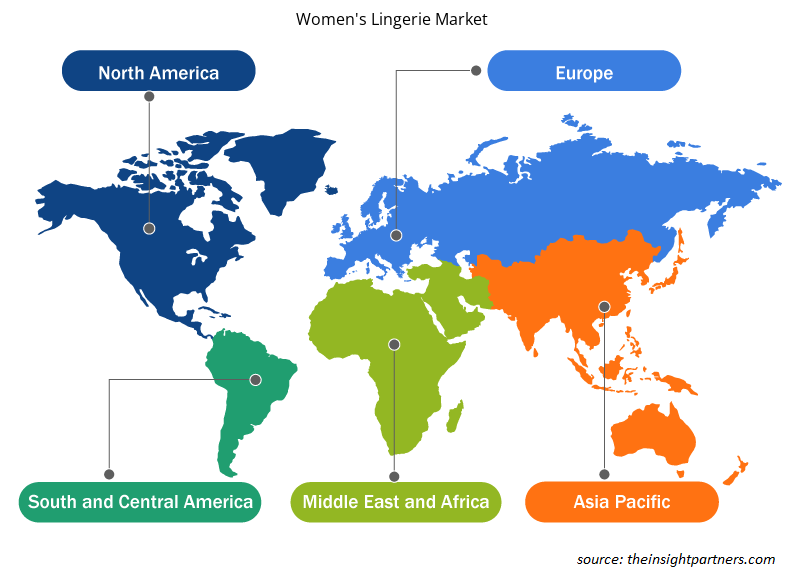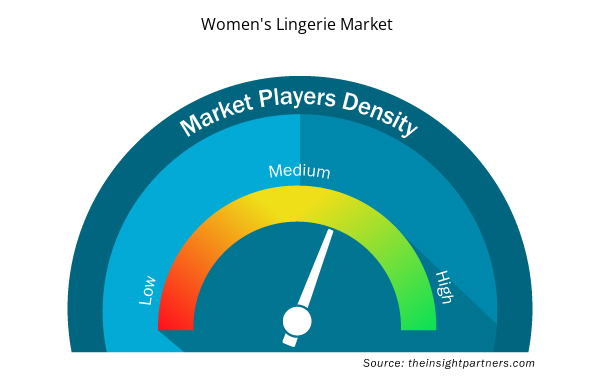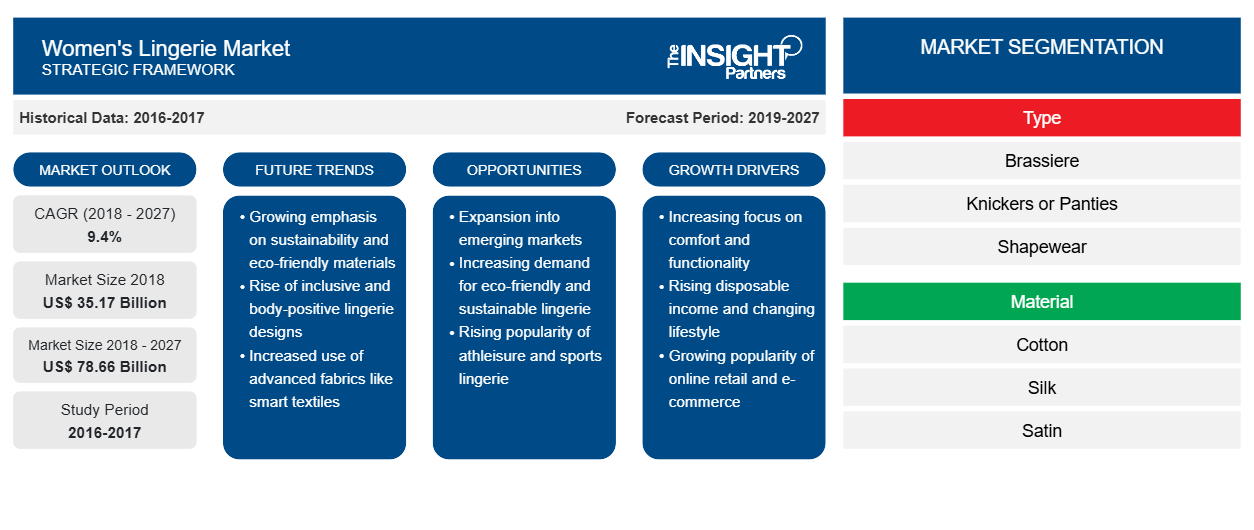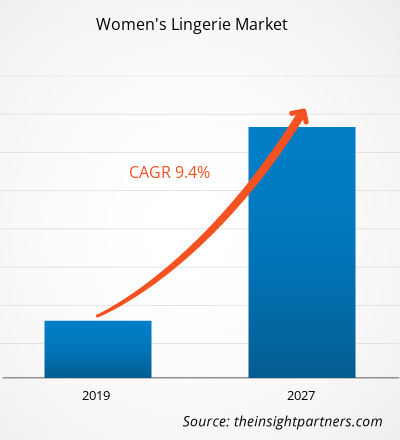2018 年女性内衣市场价值为 351.694 亿美元,预计到 2027 年将达到 786.625 亿美元,2019 年至 2027 年的复合年增长率为 9.4%。
lingerie 一词源自法语,意为内衣,专指较轻薄的女性内衣。最初的法语单词源自古老的法语单词 lingerie,意为亚麻布。lingerie 是一种由轻薄、光滑、透明、有弹性的材料制成的女性服装。女性内衣市场主要分为四种类型,如胸罩、内裤或女式内裤、塑身衣等。女性内衣市场的特点是使用缎子、棉、丝绸、尼龙等材料。女性内衣市场使用不同的渠道向消费者提供产品,例如在线、专卖店等。
预计未来几年,北美将成为全球女性内衣发展最快的市场。在预测期内,推动市场发展的因素包括提高对最佳合身度的认识、创造千禧一代群体以及提高女性的消费能力。运动、婚礼服装和传统服装等各种场合中各种产品的可获得性不断提高,推动了该地区女性内衣市场的发展。同样,更广泛的产品可获得性,以及在线和离线渠道的扩大,是推动该地区女性内衣市场发展的关键因素之一。L-Brands Inc.、Gap Inc.、Hanesbrands Inc. 和 Jockey International, Inc. 等众多市场参与者的出现,提供了大量女性内衣,例如软垫钢圈文胸、结构和美感丝带缩小文胸、带工字背的运动文胸、中高时尚女性内裤,是推动北美女性内衣市场发展的重要因素。
COVID-19 疫情于 2019 年 12 月首先在中国武汉爆发,此后迅速蔓延至全球。截至 2020 年 5 月,就确诊病例和报告死亡人数而言,中国、意大利、伊朗、西班牙、韩国、法国、德国和美国是受影响最严重的国家。根据世界卫生组织的最新数据,全球确诊病例约为 5,728,642 例,死亡人数为 353,692 例。由于封锁、旅行禁令和企业停业,COVID-19 已影响到各国的经济和行业。全球时尚和服装行业是主要行业之一,由于此次疫情,该行业面临严重中断,例如供应链中断、办公室关闭、商场、商店、零售店或品牌店关闭等。例如,中国是全球制造业中心和各行业最大的原材料供应国,也是受影响最严重的国家之一。中国各工厂的封锁正在影响全球供应链,并对包括服装在内的各种商品的制造、交货时间表和销售产生负面影响。多家公司已经宣布产品交货可能延迟,未来产品销售下滑。除此之外,欧洲、亚洲和北美国家实施的全球旅行禁令正在影响商业合作和伙伴关系机会。预计所有这些因素都将对时尚和服装行业产生负面影响,从而成为未来几个月与该行业相关的各个市场增长的制约因素。
定制此报告以满足您的需求
您可以免费定制任何报告,包括本报告的部分内容、国家级分析、Excel 数据包,以及为初创企业和大学提供优惠和折扣
- 获取此报告的关键市场趋势。这个免费样品将包括数据分析,从市场趋势到估计和预测。
市场洞察
创新产品满足顾客对时尚内衣的需求,推动全球市场增长
全球女性对时尚内衣的需求日益增长,原因是她们越来越关注内衣的最佳合身性、时尚感和舒适度。除了千禧一代人口的增长,职业女性的品牌意识不断提高和高消费能力也为市场参与者创造了有利的机会,让他们能够通过创意内衣和女性贴身衣物吸引更多客户。消费者对带有装饰、编织、奢华材料和更鲜艳色彩的产品的偏好,为制造商向市场推出新产品做出了积极贡献。大多数来自发达国家和发展中国家(例如美国、加拿大、意大利、英国、俄罗斯、日本、中国、阿联酋和沙特阿拉伯)的女性正在花费更多资金在各种场合穿着时尚内衣。制造商和供应商可以通过提供具有比以往更好功能的产品来增加最大利润并吸引消费者。预计创新的产品开发和强大的营销策略将有助于女性内衣市场的整体发展,并加强市场参与者在全球市场的地位。
类型洞察
根据类型,女性内衣市场分为胸罩、内裤或内裤、塑身衣和其他。2018 年,胸罩部分占全球女性内衣市场的大部分份额,而其他部分预计将以最快的复合年增长率增长。其他部分包括娃娃装和衬衣、吊带背心、紧身胸衣和束腰、连体衣和连体内衣等。这些女性内衣的广泛普及,加上消费者生活方式的转变和对个人外表的认识,是女性内衣市场其他部分增长的关键推动因素。
MaterialInsights
根据材料,女士内衣市场分为棉、丝、缎、尼龙等。2018 年,棉质内衣占据市场主导地位,市场份额最高,其次是丝。丝绸软缎是众所周知的最奢华面料,人们喜欢贴身穿着。它采用缎纹编织,光泽度高,外观几乎像液体一样。自 20 世纪初以来,它在内衣生产中一直很受欢迎,现在仍然在高端内衣中持续使用。许多设计师胸罩都是用丝绸/氨纶混纺面料制成的,也称为弹力丝绸软缎。更常用的衬里面料是中国丝绸,它可以成为内衣(包括衬裙)的相对便宜的选择。它贴身非常光滑,非常薄,所以不会显得臃肿。丝绸绉布用于制作奢华的家居服、睡衣、长袍、衬裙和睡衣。
分销渠道洞察
根据分销渠道,女性内衣市场分为大众商店、专卖店、在线和其他。专卖店在全球女性内衣市场中占据最高市场份额,其次是其他渠道,包括无组织的分销渠道。女性内衣分销渠道的其他部分包括百货商店、杂货店、街头市场等。这些零售商销售多种产品,包括来自各种国家和地方品牌的胸罩、内裤或内裤、塑身衣、娃娃装、紧身胸衣、连体衣和其他产品。低成本是吸引客户从这些渠道购买的主要因素。
产品开发、并购以及许可和分销协议、与分销商合作、项目合同以及销售和分销渠道增强等策略通常被公司采用,以扩大其全球影响力,这进一步影响了市场规模。全球女性内衣市场的参与者主要致力于产品开发,以满足因人们对贴身衣物的偏好不断变化而不断增长的需求。
女性内衣市场报告范围
女性内衣市场区域洞察
Insight Partners 的分析师已详尽解释了预测期内影响女性内衣市场的区域趋势和因素。本节还讨论了北美、欧洲、亚太地区、中东和非洲以及南美和中美洲的女性内衣市场细分和地理位置。

- 获取女性内衣市场的区域特定数据
女性内衣市场报告范围
| 报告属性 | 细节 |
|---|---|
| 2018 年市场规模 | 351.7亿美元 |
| 2027 年市场规模 | 786.6 亿美元 |
| 全球复合年增长率(2018 - 2027) | 9.4% |
| 史料 | 2016-2017 |
| 预测期 | 2019-2027 |
| 涵盖的领域 | 按类型
|
| 覆盖地区和国家 | 北美
|
| 市场领导者和主要公司简介 |
|
市场参与者密度:了解其对商业动态的影响
女性内衣市场正在快速增长,这得益于终端用户需求的不断增长,而这些需求又源于消费者偏好的不断变化、技术进步以及对产品优势的认识不断提高等因素。随着需求的增加,企业正在扩大其产品范围,进行创新以满足消费者的需求,并利用新兴趋势,从而进一步推动市场增长。
市场参与者密度是指在特定市场或行业内运营的企业或公司的分布情况。它表明在给定市场空间中,相对于其规模或总市场价值,有多少竞争对手(市场参与者)存在。
在女性内衣市场运营的主要公司有:
- Gap 公司
- 黛安芬国际
- 汉斯品牌公司
- 乔基国际有限公司
- Hunkemöller 国际有限公司
免责声明:上面列出的公司没有按照任何特定顺序排列。

- 了解女性内衣市场的主要参与者概况
全球女性内衣市场 – 按类型划分
- 乳罩
- 女式内裤或短裤
- 塑身衣
- 其他的
全球女性内衣市场 – 按材质划分
- 棉布
- 丝绸
- 缎
- 尼龙
- 其他的
全球女性内衣市场 – 按分销渠道划分
- 大型商场
- 专卖店
- 在线的
- 其他的
公司简介
- Gap 公司
- 黛安芬国际
- 汉斯品牌公司
- 乔基国际有限公司
- Hunkemöller 国际有限公司
- 新加坡金融管理局
- PVH 公司
- L-品牌
- 尚泰尔集团
- 手帕
- 历史分析(2 年)、基准年、预测(7 年)及复合年增长率
- PEST 和 SWOT 分析
- 市场规模价值/数量 - 全球、区域、国家
- 行业和竞争格局
- Excel 数据集



Report Coverage
Revenue forecast, Company Analysis, Industry landscape, Growth factors, and Trends

Segment Covered
This text is related
to segments covered.

Regional Scope
North America, Europe, Asia Pacific, Middle East & Africa, South & Central America

Country Scope
This text is related
to country scope.
常见问题
Fast changing consumer preferences for fashionable apparel products is driving the market growth for women’s lingerie. Lingerie is a category of women's clothing, including undergarments (mostly brassieres), sleepwear, and lightweight robes. The lingerie concept is a visually appealing undergarment, which was developed during the late nineteenth century. Consumers now days are quite aware of latest fashion trends, which are influencing the market for women’s lingerie. Also, growth in the e-commerce industry is again helping in the market growth. Most of the prominent market players, including Gap Inc., Hanesbrands Inc., Jockey International Inc., PVH Corp, L Brands, and among others display sell their lingerie items in online platforms. Purchasing products online is always a convenient and reliable option, owing to the efficient worldwide distribution network; it gets delivered on the stipulated timeline.
The brassiere women’s lingerie segment led the women’s lingerie market in 2018 with a significant share and is expected to continue its dominance during the forecast period. Brassiere or bra is a type of lingerie worn by preteen, teens, girls, and women to cover, support, and elevate the breasts, and it also shapes the wearer’s figure. The level at which the bra frames the breasts varies between style, fashion, functionality, and fabrics. There are different types of bra available in the market that are suitable for different body and breast shapes, and also for different occasions. The brassiere is essential to be in the perfect figure lines called for by the prevailing fashions. Manufacturers produce a huge variety of brassieres that serve a variety of purposes.
The women’s lingerie market was dominated by Europe, with a significant market share in 2018 and will continue to dominate the market by 2027. North-America is the second-largest contributor to the global women’s lingerie market, followed by APAC. The trend of fancy and fashionable lingerie among the female population is driving the market growth in the country. Along with this, the demand for comfortable and functional lingerie is growing among the customers, especially working females, thus encouraging manufacturers to innovate a new range of fabrics such as nylon, polyester, satin, lace, sheer, spandex, silk, and cotton for lingerie manufacturing. Consumers are more attracted to color, fabric, and style, which is encouraging the manufacturers to introduce trendy lingerie suitable for various activities.
Trends and growth analysis reports related to Consumer Goods : READ MORE..
The List of Companies - Women’s Lingerie Market
- Gap Inc.
- Triumph International
- Hanesbrands Inc.
- Jockey International, Inc.
- Hunkemöller International B.V.
- MAS Holdings
- PVH Corp.
- L Brands
- Chantelle Group
- Hanky Panky
The Insight Partners performs research in 4 major stages: Data Collection & Secondary Research, Primary Research, Data Analysis and Data Triangulation & Final Review.
- Data Collection and Secondary Research:
As a market research and consulting firm operating from a decade, we have published and advised several client across the globe. First step for any study will start with an assessment of currently available data and insights from existing reports. Further, historical and current market information is collected from Investor Presentations, Annual Reports, SEC Filings, etc., and other information related to company’s performance and market positioning are gathered from Paid Databases (Factiva, Hoovers, and Reuters) and various other publications available in public domain.
Several associations trade associates, technical forums, institutes, societies and organization are accessed to gain technical as well as market related insights through their publications such as research papers, blogs and press releases related to the studies are referred to get cues about the market. Further, white papers, journals, magazines, and other news articles published in last 3 years are scrutinized and analyzed to understand the current market trends.
- Primary Research:
The primarily interview analysis comprise of data obtained from industry participants interview and answers to survey questions gathered by in-house primary team.
For primary research, interviews are conducted with industry experts/CEOs/Marketing Managers/VPs/Subject Matter Experts from both demand and supply side to get a 360-degree view of the market. The primary team conducts several interviews based on the complexity of the markets to understand the various market trends and dynamics which makes research more credible and precise.
A typical research interview fulfils the following functions:
- Provides first-hand information on the market size, market trends, growth trends, competitive landscape, and outlook
- Validates and strengthens in-house secondary research findings
- Develops the analysis team’s expertise and market understanding
Primary research involves email interactions and telephone interviews for each market, category, segment, and sub-segment across geographies. The participants who typically take part in such a process include, but are not limited to:
- Industry participants: VPs, business development managers, market intelligence managers and national sales managers
- Outside experts: Valuation experts, research analysts and key opinion leaders specializing in the electronics and semiconductor industry.
Below is the breakup of our primary respondents by company, designation, and region:

Once we receive the confirmation from primary research sources or primary respondents, we finalize the base year market estimation and forecast the data as per the macroeconomic and microeconomic factors assessed during data collection.
- Data Analysis:
Once data is validated through both secondary as well as primary respondents, we finalize the market estimations by hypothesis formulation and factor analysis at regional and country level.
- Macro-Economic Factor Analysis:
We analyse macroeconomic indicators such the gross domestic product (GDP), increase in the demand for goods and services across industries, technological advancement, regional economic growth, governmental policies, the influence of COVID-19, PEST analysis, and other aspects. This analysis aids in setting benchmarks for various nations/regions and approximating market splits. Additionally, the general trend of the aforementioned components aid in determining the market's development possibilities.
- Country Level Data:
Various factors that are especially aligned to the country are taken into account to determine the market size for a certain area and country, including the presence of vendors, such as headquarters and offices, the country's GDP, demand patterns, and industry growth. To comprehend the market dynamics for the nation, a number of growth variables, inhibitors, application areas, and current market trends are researched. The aforementioned elements aid in determining the country's overall market's growth potential.
- Company Profile:
The “Table of Contents” is formulated by listing and analyzing more than 25 - 30 companies operating in the market ecosystem across geographies. However, we profile only 10 companies as a standard practice in our syndicate reports. These 10 companies comprise leading, emerging, and regional players. Nonetheless, our analysis is not restricted to the 10 listed companies, we also analyze other companies present in the market to develop a holistic view and understand the prevailing trends. The “Company Profiles” section in the report covers key facts, business description, products & services, financial information, SWOT analysis, and key developments. The financial information presented is extracted from the annual reports and official documents of the publicly listed companies. Upon collecting the information for the sections of respective companies, we verify them via various primary sources and then compile the data in respective company profiles. The company level information helps us in deriving the base number as well as in forecasting the market size.
- Developing Base Number:
Aggregation of sales statistics (2020-2022) and macro-economic factor, and other secondary and primary research insights are utilized to arrive at base number and related market shares for 2022. The data gaps are identified in this step and relevant market data is analyzed, collected from paid primary interviews or databases. On finalizing the base year market size, forecasts are developed on the basis of macro-economic, industry and market growth factors and company level analysis.
- Data Triangulation and Final Review:
The market findings and base year market size calculations are validated from supply as well as demand side. Demand side validations are based on macro-economic factor analysis and benchmarks for respective regions and countries. In case of supply side validations, revenues of major companies are estimated (in case not available) based on industry benchmark, approximate number of employees, product portfolio, and primary interviews revenues are gathered. Further revenue from target product/service segment is assessed to avoid overshooting of market statistics. In case of heavy deviations between supply and demand side values, all thes steps are repeated to achieve synchronization.
We follow an iterative model, wherein we share our research findings with Subject Matter Experts (SME’s) and Key Opinion Leaders (KOLs) until consensus view of the market is not formulated – this model negates any drastic deviation in the opinions of experts. Only validated and universally acceptable research findings are quoted in our reports.
We have important check points that we use to validate our research findings – which we call – data triangulation, where we validate the information, we generate from secondary sources with primary interviews and then we re-validate with our internal data bases and Subject matter experts. This comprehensive model enables us to deliver high quality, reliable data in shortest possible time.


 获取此报告的免费样本
获取此报告的免费样本